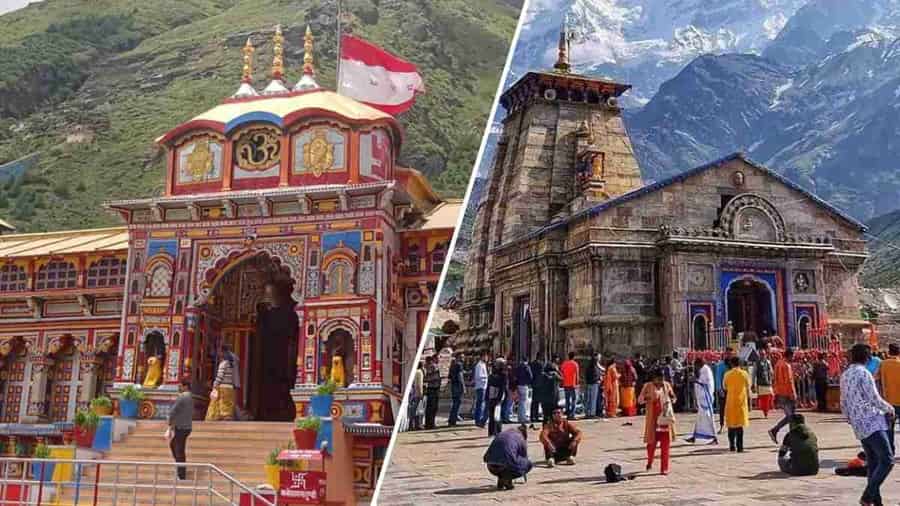If you’re embarking on a sacred journey to Kedarnath and Badrinath, Delhi is the best city to start from. But, before that, you are required to have a solid itinerary or plan for your Yatra to go much smoother and enjoyable. The distance between these religious abodes and Delhi is approximately 600 km, which will take about 5 to 6 days to complete.
Kedarnath and Badrinath are settled across the mountainous region of Uttarakhand, serving as abodes of Lord Shiva and Lord Vishnu respectively. The trek to these temples includes the rocky and rugged terrains. However, the scenic aroma of the vicinity makes it all worth it.
We’ve gladly written this comprehensive guide to help you better plan for what to take when to visit, a few key tips, and a delegated route map to the pilgrimage from Delhi, the capital of India.

Importance of Badrinath and Kedarnath
- Talking about that, Badrinath and Kedarnath, are both spiritual centers in Hinduism. These revered sites welcome thousands of pilgrims during the six months of the year when they are open.
- Their importance is highly expressed by the devotees despite traveling several kilometers, walking through challenging paths, trekking uneven ascents, and undergoing extreme pain. Yet, just a glimpse of their beloved deities makes all the sufferings disappear.
- As the ancient texts suggest, Kedarnath, the place of Mahadev and Badrinath, the place of Badrivishal, are religiously significant in the Kalyuga, one of the four Yugas, described in Hinduism. The greatness of the shrines also showcases the divine faith and respect devotees have towards their God.
- For Kedarnath, they believe it is the place where Lord Shiva emerged from the ground in the disguise of a Bull’s hump after being hidden from the Pandavas, who were seeking his forgiveness for the evil deeds they performed in the Mahabharata war.
- For Badrinath, it’s said to be the spot where Shri Narayan himself meditated. A quote in The Skanda Purana goes like this, “There are numerous religious sites in heaven, on earth, and in hell; but there is no pious site like Badrinath.”
- Moreover, Kedarnath is one of the 12 Jyotirlingas (self-manifestations) of Lord Shiva across India, and Badrinath is among the four major pilgrimages (char Dham) of India and 108 Divya Desams.
Why Start the Yatra from Delhi
Delhi performs as a gateway to almost every corner of the nation and has the best shuttle facilities. It’s almost like a hub with direct flights, trains, and buses to Uttarakhand. Therefore, Delhi is an ideal option for both Indians and foreigners to start their journey to the two most revered temples of Uttarakhand.
As you reach Delhi, you can either hire a local vehicle, book a flight, or take a train or bus to reach Haridwar, Rishikesh, or Dehradun. All of these are very well connected to the starting point of the Yatra.
Best Time to Visit
These two holy Dhams are generally accessible from last April or Start May to October when the thick layer of ice melts and gives way to trekking. However, the best time to visit both of these temples Kedarnath and Badrinath from Delhi is either between April to June or September to October. We are eliminating July and August as they are the wettest season, leaving the routes slippery, and regular landslides are observed due to heavy rainfall in the regions.
Summer (April – June)
It presents a gentle and pleasant atmosphere, with maximum day temperature ranging from 18°-20°C. The peaks of the Himalayas are clearly visible and a treat to the eye.
Post Monsoon (September – October)
The post-monsoon season, after rain, brings a cool and placid environment to the area. Temperatures get cooler and range between 15-18°C. These are the most ideal months for your visit.
Transportation Options
Here are the transportation options that you can choose from to travel from Delhi:
By Air
You can fly to Jolly Grant Airport, Dehradun from Delhi to start your pilgrimage. On reaching, you can either take a cab or a local bus to Sonprayag for Kedarnath and Joshimath for Badrinath.
By Rail
The nearest station to both Kedarnath and Badrinath is in Haridwar and Rishikesh. You can choose a train to any of these and then take public or private transport to reach the starting point.
By Road
There are direct buses available to both Kedarnath and Badrinath, which are operated by the state government. These are totally safe and an affordable option.
Route Map
Kedarnath By Road:
Delhi → Haridwar → Rishikesh → Devprayag → Srinagar → Rudraprayag → Guptkashi → Sonprayag → Gaurikund → Kedarnath
Delhi- Kedarnath: 450-470 km approx
Badrinath By Road
Delhi → Haridwar → Rishikesh → Devprayag → Srinagar → Rudraprayag → Karnaprayag → Chamoli → Joshimath → Badrinath
Delhi- Badrinath: 535-538 km approx
What to Pack
A list of what you must pack:
- Sufficient woolen clothes
- I’d proofs, including your Aadhaar Card, PAN card, Voter ID, and passport (if required)
- Multiple copies of the Yatra permit and registration.
- Hiking boots with a good grip and must be waterproof
- First Aid kit, including your prescribed medicines
- Personal Hygiene, sanitary items, and Toiletries
- Rain Gear, such as a raincoat and a bag cover
- Enough Cash, as you may not find frequent ATM stops
- Sunscreen, Sunglasses, Cap, Trekking Pole, Charger, power bank, torch, and such essentials.
Process of Registration
Online:
- First of all you should visit the official tourism portal of the state government and create an account if you’re new.
- Thereafter, you should fill out the registration form, providing your basic personal details.
- At the end, you can submit the form, pay the fees, and download your registration or E-pass confirmation.
Offline:
- You can reach out to the centers available in Haridwar, Rishikesh, Joshimath, or the ones at another point as well.
- You’ll be asked to submit the required documents, such as your, I’d proofs, contact details, and photos (passport size)
- Afterward, pay a minimal fee, which is variable. You’ll be given a physical copy of your registration, and you’re good to go.
Health and Safety Guidelines:
Here are a few tips on how to be safe throughout the trek:
- Both of the temples are highly elevated, and hence, we suggest you spend a day in the base camp to help your body adapt to the heights.
- You must not rush while ascending, as there are several risks involved, both physical and natural.
- Before the trip, you must undergo a full-body medical check-up and bring the prescribed medicines along.
- You need to stay hydrated at all times as the trek continuously feeds on your energy and stamina.
- You must intake light and nutritious food to avoid bloating and nausea.
- We advise you to wear layered clothes and be prepared for sudden weather changes.
Conclusion
Kedarnath and Badrinath are undoubtedly the most significant and revered sites among Hindus. And, we are frequently observing an increment in the numbers of devotees taking this pilgrimage, given the fact, it becomes our duty to bring the necessary and detailed information for you to plan in the best ways possible.
We hope this article aids in solving a few of your queries and help you curate an ideal Itinerary to commence the sacred tour to Kedarnath Badrinath from Delhi.

 Call
Call WhatsApp
WhatsApp Enquiry
Enquiry